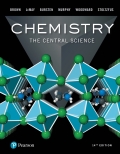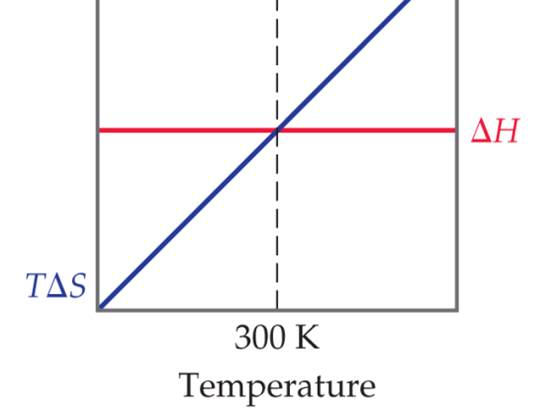
EBK CHEMISTRY:CENTRAL SCIENCE
14th Edition
ISBN: 9780134554570
Author: Brown
Publisher: PEARSON
expand_more
expand_more
format_list_bulleted
Textbook Question
Chapter 19, Problem 7E
The accompanying diagram shows how ΔH (red line) and TΔS (Blue line) change with temperature for a hypothetical reaction.
- What is the significance of the point at 300 K, where ΔH and TΔS are equal?
- In what temperature range is the reaction spontaneous? [Section 19.6]


Expert Solution & Answer
Want to see the full answer?
Check out a sample textbook solution
Students have asked these similar questions
b. Please complete the zig-zag conformation of the compound
(3R,4S)-3,4-dichloro-2,5-dimethylhexane by writing the respective atoms in the boxes.
4
c. Serricornin, the female-produced sex pheromone of the cigarette beetle, has the following structure.
OH
What is the maximum number of possible stereoisomers?
Is this structure a meso compound?
d. Please consider the natural product alkaloids shown below.
Are these two structures enantiomers, diastereomers or conformers?
H
HO
H
H
HN
HO
HN
R
R
с
R=H
cinchonidine
R=ET
cinchonine
H
Nail polish remover containing acetone was spilled in a room 5.23 m × 3.28 m × 2.76 m.
Measurements indicated that 2,250 mg of acetone evaporated. Calculate the acetone concentration in micrograms per cubic meter.
Chapter 19 Solutions
EBK CHEMISTRY:CENTRAL SCIENCE
Ch. 19.1 - The process of iron being oxidized to make iron...Ch. 19.1 - At 1 atm pressure, CO2(s) sublimes at 78oC. Is...Ch. 19.2 - Prob. 19.2.1PECh. 19.2 - Prob. 19.2.2PECh. 19.3 - Prob. 19.3.1PECh. 19.3 - Prob. 19.3.2PECh. 19.3 - Prob. 19.4.1PECh. 19.3 - Prob. 19.4.2PECh. 19.4 - Prob. 19.5.1PECh. 19.4 - Using the standard molar entropies in Appendix C,...
Ch. 19.5 - Which of these statements is true? All spontaneous...Ch. 19.5 - Prob. 19.6.2PECh. 19.5 - Prob. 19.7.1PECh. 19.5 - Prob. 19.7.2PECh. 19.5 - Prob. 19.8.1PECh. 19.5 - Prob. 19.8.2PECh. 19.6 - What is the temperature above which the Haber...Ch. 19.6 - Prob. 19.9.2PECh. 19.7 - Prob. 19.10.1PECh. 19.7 - Prob. 19.10.2PECh. 19.7 - Prob. 19.11.1PECh. 19.7 - Prob. 19.11.2PECh. 19.7 - Prob. 19.12.1PECh. 19.7 - Prob. 19.12.2PECh. 19 - Prob. 1DECh. 19 - Prob. 1ECh. 19 - As shown here, one type of computer keyboard...Ch. 19 - 19.3
a. What are the signs of ΔS and ΔH for the...Ch. 19 - Predict the signs of H and S for this reaction....Ch. 19 - The accompanying diagram shows how entropy varies...Ch. 19 - Prob. 6ECh. 19 - The accompanying diagram shows how H (red line)...Ch. 19 - Prob. 8ECh. 19 - Prob. 9ECh. 19 - Prob. 10ECh. 19 - Prob. 11ECh. 19 - Prob. 12ECh. 19 - Prob. 13ECh. 19 - Can endothermic chemical reaction be spontaneous?...Ch. 19 - Prob. 15ECh. 19 - Prob. 16ECh. 19 - Prob. 17ECh. 19 - Prob. 18ECh. 19 - Prob. 19ECh. 19 - Prob. 20ECh. 19 - Prob. 21ECh. 19 - Prob. 22ECh. 19 - Prob. 23ECh. 19 - Prob. 24ECh. 19 - Prob. 25ECh. 19 - Prob. 26ECh. 19 - Prob. 27ECh. 19 - Prob. 28ECh. 19 - Prob. 29ECh. 19 - Prob. 30ECh. 19 - Prob. 31ECh. 19 - Using the heat of vaporization in Appendix B,...Ch. 19 - Prob. 33ECh. 19 - Prob. 34ECh. 19 - Prob. 35ECh. 19 - Prob. 36ECh. 19 - Prob. 37ECh. 19 - Prob. 38ECh. 19 - For each of the following pairs, predict which...Ch. 19 - For each of the following pairs, predict which...Ch. 19 - Predict the sign of the entropy change of the...Ch. 19 - Prob. 42ECh. 19 - Prob. 43ECh. 19 - 19.44 Propanol (C3H7OH) melts at – 126.5 o C and...Ch. 19 - Prob. 45ECh. 19 - Prob. 46ECh. 19 - Prob. 47ECh. 19 - Prob. 48ECh. 19 - Prob. 49ECh. 19 - Prob. 50ECh. 19 - Using So values from Appendix C, calculate So...Ch. 19 - Calculate So values for the following reactions by...Ch. 19 - Prob. 53ECh. 19 - Prob. 54ECh. 19 - For a certain chemical reaction, Ho = -35.4 kJ and...Ch. 19 - A certain reaction has Ho = +23.7.kJ and So = +...Ch. 19 - Using data in Appendix C, calculate Ho, So, and Go...Ch. 19 - Prob. 58ECh. 19 - Prob. 59ECh. 19 - Prob. 60ECh. 19 - Prob. 61ECh. 19 - Prob. 62ECh. 19 - Prob. 63ECh. 19 - Prob. 64ECh. 19 - Prob. 65ECh. 19 - Prob. 66ECh. 19 - Prob. 67ECh. 19 - Prob. 68ECh. 19 - Prob. 69ECh. 19 - Prob. 70ECh. 19 - a. Use data in Appendix c to estimate the boiling...Ch. 19 - Prob. 72ECh. 19 - Prob. 73ECh. 19 - Prob. 74ECh. 19 - Prob. 75ECh. 19 - Prob. 76ECh. 19 - Prob. 77ECh. 19 - 19.78 Consider the reaction 3CH4(g) C3H8(g) ...Ch. 19 - Use data from Appendix C to calculate the...Ch. 19 - Prob. 80ECh. 19 - Prob. 81ECh. 19 - Prob. 82ECh. 19 - Prob. 83ECh. 19 - Prob. 84ECh. 19 - Prob. 85AECh. 19 - Prob. 86AECh. 19 - Prob. 87AECh. 19 - Prob. 88AECh. 19 - Prob. 89AECh. 19 - Prob. 90AECh. 19 - Prob. 91AECh. 19 - Prob. 92AECh. 19 - Prob. 93AECh. 19 - Prob. 94AECh. 19 - Prob. 95AECh. 19 - Prob. 96AECh. 19 - Prob. 97AECh. 19 - Prob. 98AECh. 19 - Prob. 99AECh. 19 - Prob. 100AECh. 19 - Prob. 101AECh. 19 - Prob. 102AECh. 19 - Most liquids follow Trouton’s rule (see Exercise...Ch. 19 - In chemical kinetics, the entropy of activation is...Ch. 19 - Prob. 105IECh. 19 - Prob. 106IECh. 19 - Prob. 107IECh. 19 - Prob. 108IECh. 19 - The following data compare the standard enthalpies...Ch. 19 - Prob. 110IECh. 19 - Prob. 111IECh. 19 - Prob. 112IE
Knowledge Booster
Learn more about
Need a deep-dive on the concept behind this application? Look no further. Learn more about this topic, chemistry and related others by exploring similar questions and additional content below.Similar questions
- Please help me answer number 1. 1. If your graphs revealed a mathematical relationship between specific heat and atomic mass, write down an equation for the relationship. I also don't understand, is the equation from the line regression the one that I'm suppose use to show the relationship? If so could you work it all the way out?arrow_forwardDescribe the principle of resonance and give a set of Lewis Structures to illustrate your explanation.arrow_forwardDon't used hand raitingarrow_forward
- It is not unexpected that the methoxyl substituent on a cyclohexane ring prefers to adopt the equatorial conformation. OMe H A G₂ = +0.6 kcal/mol OMe What is unexpected is that the closely related 2-methoxytetrahydropyran prefers the axial conformation: H H OMe OMe A Gp=-0.6 kcal/mol Methoxy: CH3O group Please be specific and clearly write the reason why this is observed. This effect that provides stabilization of the axial OCH 3 group in this molecule is called the anomeric effect. [Recall in the way of example, the staggered conformer of ethane is more stable than eclipsed owing to bonding MO interacting with anti-bonding MO...]arrow_forward206 Pb 82 Express your answers as integers. Enter your answers separated by a comma. ▸ View Available Hint(s) VAΣ ΜΕ ΑΣΦ Np, N₁ = 82,126 Submit Previous Answers ? protons, neutronsarrow_forwardPlease draw the inverted chair forms of the products for the two equilibrium reactions shown below. Circle the equilibrium reaction that would have a AG = 0, i.e., the relative energy of the reactant (to the left of the equilibrium arrows) equals the relative energy of the product? [No requirement to show or do calculations.] CH3 CH3 HH CH3 1 -CH3arrow_forward
- 5. Please consider the Newman projection of tartaric acid drawn below as an eclipsed conformer (1). Please draw the most stable conformer and two intermediate energy conformers noting that staggered conformers are lower in energy than eclipsed forms even if the staggered conformers have gauche relationships between groups. [Draw the substituents H and OH on the front carbons and H, OH and CO₂H on the back carbons based on staggered forms. -CO₂H is larger than -OH.] OH COH ICOOH COOH COOH 1 2 COOH COOH 3 4 Staggered Staggered Staggered (most stable) Indicate the number of each conformer above (1, 2, 3 and 4) that corresponds to the relative energies below. Ref=0 Rotation 6. (60 points) a. Are compounds 1 and 2 below enantiomers, diastereomers or identical? OH OH HO HO LOH HO HO OH 2 OH OH b. Please complete the zig-zag conformation of the compound (3R,4S)-3,4-dichloro-2,5-dimethylhexane by writing the respective atoms in the boxes. 3.arrow_forwardThe plutonium isotope with 144 neutrons Enter the chemical symbol of the isotope.arrow_forwardThe mass ratio of sodium to fluorine in sodium fluoride is 1.21:1. A sample of sodium fluoride produced 26.1 gg of sodium upon decomposition. How much fluorine was formed?arrow_forward
- 32S 16 Enter your answers numerically separated by a comma. Np. Nn = 跖 ΟΙ ΑΣΦ Submit Request Answer ? protons, neutronsarrow_forward2. Which dimethylcyclohexane compounds shown below exhibit symmetry and therefore are not chiral and would not rotate plane polarized light. 1 CH3 CH CH3 CH3 2 3 CH3arrow_forwardDon't used hand raitingarrow_forward
arrow_back_ios
SEE MORE QUESTIONS
arrow_forward_ios
Recommended textbooks for you
 General Chemistry - Standalone book (MindTap Cour...ChemistryISBN:9781305580343Author:Steven D. Gammon, Ebbing, Darrell Ebbing, Steven D., Darrell; Gammon, Darrell Ebbing; Steven D. Gammon, Darrell D.; Gammon, Ebbing; Steven D. Gammon; DarrellPublisher:Cengage Learning
General Chemistry - Standalone book (MindTap Cour...ChemistryISBN:9781305580343Author:Steven D. Gammon, Ebbing, Darrell Ebbing, Steven D., Darrell; Gammon, Darrell Ebbing; Steven D. Gammon, Darrell D.; Gammon, Ebbing; Steven D. Gammon; DarrellPublisher:Cengage Learning ChemistryChemistryISBN:9781305957404Author:Steven S. Zumdahl, Susan A. Zumdahl, Donald J. DeCostePublisher:Cengage Learning
ChemistryChemistryISBN:9781305957404Author:Steven S. Zumdahl, Susan A. Zumdahl, Donald J. DeCostePublisher:Cengage Learning Chemistry: An Atoms First ApproachChemistryISBN:9781305079243Author:Steven S. Zumdahl, Susan A. ZumdahlPublisher:Cengage Learning
Chemistry: An Atoms First ApproachChemistryISBN:9781305079243Author:Steven S. Zumdahl, Susan A. ZumdahlPublisher:Cengage Learning
 Principles of Modern ChemistryChemistryISBN:9781305079113Author:David W. Oxtoby, H. Pat Gillis, Laurie J. ButlerPublisher:Cengage Learning
Principles of Modern ChemistryChemistryISBN:9781305079113Author:David W. Oxtoby, H. Pat Gillis, Laurie J. ButlerPublisher:Cengage Learning Chemistry: The Molecular ScienceChemistryISBN:9781285199047Author:John W. Moore, Conrad L. StanitskiPublisher:Cengage Learning
Chemistry: The Molecular ScienceChemistryISBN:9781285199047Author:John W. Moore, Conrad L. StanitskiPublisher:Cengage Learning

General Chemistry - Standalone book (MindTap Cour...
Chemistry
ISBN:9781305580343
Author:Steven D. Gammon, Ebbing, Darrell Ebbing, Steven D., Darrell; Gammon, Darrell Ebbing; Steven D. Gammon, Darrell D.; Gammon, Ebbing; Steven D. Gammon; Darrell
Publisher:Cengage Learning

Chemistry
Chemistry
ISBN:9781305957404
Author:Steven S. Zumdahl, Susan A. Zumdahl, Donald J. DeCoste
Publisher:Cengage Learning

Chemistry: An Atoms First Approach
Chemistry
ISBN:9781305079243
Author:Steven S. Zumdahl, Susan A. Zumdahl
Publisher:Cengage Learning


Principles of Modern Chemistry
Chemistry
ISBN:9781305079113
Author:David W. Oxtoby, H. Pat Gillis, Laurie J. Butler
Publisher:Cengage Learning

Chemistry: The Molecular Science
Chemistry
ISBN:9781285199047
Author:John W. Moore, Conrad L. Stanitski
Publisher:Cengage Learning
The Laws of Thermodynamics, Entropy, and Gibbs Free Energy; Author: Professor Dave Explains;https://www.youtube.com/watch?v=8N1BxHgsoOw;License: Standard YouTube License, CC-BY